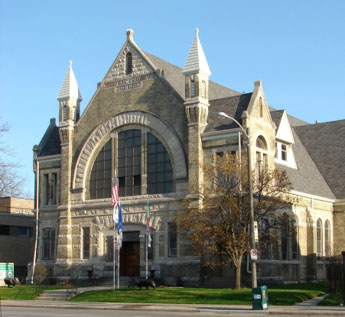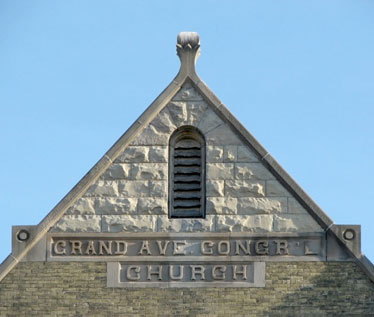17. Grand Avenue Congregational, 1887
Now the Irish Cultural and Heritage Center of Wisconsin
2133 West Wisconsin Avenue
Architect: Edward Townsend Mix
Built four years after St. Paul’s Episcopal and also designed by Edward Townsend Mix, Grand Avenue Congregational is Milwaukee’s only other Richardsonian Romanesque church. (Mix designed a third church in the style in 1889, Plymouth Congregational, but the building is now the Scottish Rite Masonic Center and was completely remodeled in the 1930s in the Art Deco style.) Grand Avenue Congregational has exterior walls of Cream City brick and a combination of smooth and quarry-faced limestone. The different materials give the exterior walls a highly textured surface, as is characteristic of the Richardsonian Romanesque style. The church is unusual for its time in having no bell tower. The most prominent feature on the façade is the large arched window above the entrance, which is 25 feet in width and 16 feet high. With a seating capacity of 1,200 to 1,500, Grand Avenue Congregational was the largest Protestant worship space in the city at the time of its construction, and remained one of the largest until it ceased to serve as a church in the 1990s.
The congregation formed in 1847, when a small group of men and women left Milwaukee’s First Congregational and First Presbyterian churches to found the Free Congregational Church. This new church had its origins in the growing abolitionist sentiment of the decades leading up to the Civil War. The abolition of slavery was a controversial issue in Milwaukee in the 1840s, and the First Presbyterian Church refused to allow the preaching of abolitionist sermons or the use of its building for political meetings. The First Congregational Church took a similarly muted stance on the issue of slavery. The dissident group who founded the Free Congregational Church wanted a more activist church that would offer its pulpit to anti-slavery speakers and its facilities for abolitionist meetings.
The new church met in several locations during its first four decades, changing its name to Spring Street Congregational in 1852 and Grand Avenue Congregational in 1881. By the mid-1880s, the expanding downtown commercial district and residential growth to the west led the church to plan another move from its location at 6th Street and Grand Avenue (now Wisconsin Avenue). The church acquired property on Grand Avenue at 22nd Street, a location more convenient to the majority of its members, and began construction of a new church in 1887. This was to be the congregation’s home for more than one hundred years.
Throughout its history, the congregation took an active role in the social and political issues of the day, often making its large auditorium available for public meetings. For example, when Martin Luther King, Jr. visited Milwaukee in 1957, he gave a public address at the church. Just 28 years old at the time, King had recently come to nationwide prominence as the leader of the Montgomery bus boycott of 1955 and founder of the Southern Christian Leadership Conference earlier in 1957. More than 1,200 people filled the church auditorium and balconies to hear King’s speech, sponsored by the Milwaukee chapter of the NAACP.
Declining membership led the congregation to dissolve in the late 1990s, shortly after transferring ownership of the building to the Irish Cultural and Heritage Center of Wisconsin. The new owners have taken care to preserve the building’s original materials and historic character, while using the building for Irish music and dance performances, organ concerts, and other activities.
Sources:
“Among the Architects,” Milwaukee Sentinel, July 8, 1887, page 4, column 5.
Boardman, M. A. Historical Sketch; Grand Avenue Congregational Church of Milwaukee, 1847-1907. Grand Avenue Congregational Church, c. 1907.
“Bus Boycott Leader Lists Negroes Gains,” Milwaukee Sentinel, August 15, 1957, part 1, page 2, column 1.
Grand Avenue Congregational Church, 1847-1947: One Hundred Years of Christian Service. Grand Avenue Congregational Church, 1947.
Irish Cultural and Heritage Center of Wisconsin, website at www.ichc.net.
Janett, Rev. J. P. “Rev. Beale’s Church Born of Abolition,” Milwaukee Sentinel, May 7, 1927, page 6, column 1.

